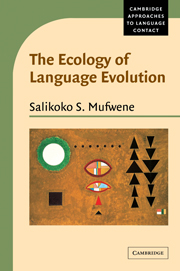Book contents
- Frontmatter
- Contents
- List of illustrations
- Preface
- Acknowledgments
- 1 Introduction
- 2 The Founder Principle in the development of creoles
- 3 The development of American Englishes: factoring contact in and the social bias out
- 4 The legitimate and illegitimate offspring of English
- 5 What research on the development of creoles can contribute to genetic linguistics
- 6 Language contact, evolution, and death: how ecology rolls the dice
- 7 Past and recent population movements in Africa: their impact on its linguistic landscape
- 8 Conclusions: the big picture
- Notes
- References
- Author index
- Subject index
1 - Introduction
Published online by Cambridge University Press: 18 December 2009
- Frontmatter
- Contents
- List of illustrations
- Preface
- Acknowledgments
- 1 Introduction
- 2 The Founder Principle in the development of creoles
- 3 The development of American Englishes: factoring contact in and the social bias out
- 4 The legitimate and illegitimate offspring of English
- 5 What research on the development of creoles can contribute to genetic linguistics
- 6 Language contact, evolution, and death: how ecology rolls the dice
- 7 Past and recent population movements in Africa: their impact on its linguistic landscape
- 8 Conclusions: the big picture
- Notes
- References
- Author index
- Subject index
Summary
This chapter is written primarily to clarify concepts such as “ecology,” “evolution,” and “language,” which are central to the book. It also states some of my most important arguments, e.g., (1) creoles have developed by the same restructuring processes that mark the evolutions of noncreole languages; (2) contact is an important factor in all such developments; and (3) the external ecological factors that bear on restructuring also bear on aspects of language vitality, among which is language endangerment. I will go beyond the brief explanations given in the Preface but will not pre-empt the more elaborate discussions presented in, for instance, chapters 2 and 6. In the present chapter, I simply provide basic information that readers will find useful to understand the book.
Communal languages as ensembles of I-languages
To the lay person the term language means something like “way of speaking.” Thus English originally meant “the way the English people speak” and kiSwahili “the way the waSwahili speak.” In the case of kiSwahili, the Bantu noun class system makes it clear through the instrumental prefix ki-, which suggests a means used by waSwahili to communicate. Those more knowledgeable about communication extend the notion “language” beyond the spoken mode, applying it also to written and signed means.
Linguists have focused more on the abstract systems that generate utterances and written or signed strings of symbols identified as English, American Signed Language, or the like in lay speech.
- Type
- Chapter
- Information
- The Ecology of Language Evolution , pp. 1 - 24Publisher: Cambridge University PressPrint publication year: 2001

